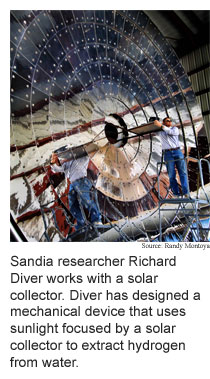
February
13, 2006
Rings
turn out hydrogen
Hydrogen promises to be a clean fuel, if scientists can find clean
ways of generating it. One of the most promising methods is using sunlight
to split water into oxygen and hydrogen. Although it may sound simple,
making the process practical is a challenge.
 A researcher at Sandia National Laboratories have literally got
the wheels spinning with a proposed mechanical solar water
splitting device. Solar water splitters use a chemical catalyst to
speed the reaction that breaks down water molecules. These are usually
stationary.
A researcher at Sandia National Laboratories have literally got
the wheels spinning with a proposed mechanical solar water
splitting device. Solar water splitters use a chemical catalyst to
speed the reaction that breaks down water molecules. These are usually
stationary.
The Counter Rotating Ring Receiver Reactor Recuperator is a horizontal
stack of rings made from iron oxide mixed with the oxide of another metal
like cobalt, magnesium or nickel. First the rings rotate through concentrated
sunlight, where oxygen is stripped from the rings. They then pass through
the cold side of the device, where they remove oxygen from water, leaving
hydrogen. Each ring rotates in the opposite direction of its neighbors,
which transfers heat between them to conserve energy.
The device would be used with solar collectors, which resemble
large dish antennas with mirrored interiors. They could be used to produce
hydrogen gas that could be used as fuel for hydrogen-powered vehicles.
(unpublished research reported in Sandia Lab News, February
3, 2006)
Nanotubes hold more electricity
Capacitors are capable of delivering large bursts of electricity
but hold much less energy than batteries. Carbon nanotubes could change
that, bringing about energy storing devices that combine the best of both
worlds.
Researchers have been using carbon nanotubes to boost the storage
capacity and performance of batteries and capacitors in recent years.
(See Nanotubes
pack power, TRN, February 27, 2002)
An MIT research team has designed an ultracapacitor
that uses dense vertical arrays of single-walled carbon nanotubes as an
electrode to store charge. The nanotube electrode promises to give capacitors
storage capacities comparable to batteries. The nanotubes, each only a
few millionths of a millimeter in diameter, provide a much larger surface
area than the traditionally used porous carbon electrodes.
The technology could eventually be used to provide longer running
times for electric cars and portable devices like computers and cellphones,
which use capacitors to supply sudden power needs.
(Carbon Nanotube Enhanced Ultracapacitor, 15th International Seminar
on Double Layer Capacitors and Hybrid Energy Storage Devices, Deerfield
Beach, Florida, December 5-7, 2005)
Bits and pieces
Nanotubes boost solar cells
Ordered arrays of titanium oxide nanotubes
make for efficient solar cells and have the potential to reach efficiencies
comparable to today's silicon chip-based solar technology. The nanotube
devices are easier to manufacture than silicon solar cells and have the
potential to make photovoltaics commercially viable for a wide range of
electricity needs.
(Use of Highly-Ordered TiO2 Nanotube Arrays in Dye-Sensitized
Solar Cells, Nano Letters, February 8, 2006)
We follow the herd, culturally
A study
has shown that when it comes to buying cultural items -- music, books,
movies -- we are strongly influenced by choices others have made. This
not only assures that popular items sell well -- the rich get richer phenomenon
-- but it makes it hard to predict what people will buy.
(Experimental Study of Inequality and Unpredictability in an Artificial
Cultural Market, Science, February 2006)
Multilevel optical disk scheme
A design
for recording data in as many as eight layers in optical read-only disks
could boost DVD storage capacity to 20 gigabytes, and even higher if shorter-wavelength
lasers are used to record data. Twenty gigabytes is more than four times
the capacity of today's DVDs.
(Modeling and Realization of a Multilevel Read-Only Disk, Optics
Express, February 6, 2006)
Motion sensor on a chip
A low-power motion
sensor that crams an accelerometer, gyroscope and wireless transmitter
on a three-square-millimeter chip could be used in cellphones and other
portable devices, clothing and even implanted in the body.
(Low-Power CMOS Wireless MEMS Motion Sensor for Physiological
Activity Monitoring, IEEE Transactions on Circuits and Systems,
December 2005)
RSS Feeds: News Blog Books New: TRN's Internet Services TRN's Jobs Center News: Research News Roundup Research Watch blog Features: View from the High Ground Q&A How It Works Buy an ad link |
|
| Advertisements: |
|
Ad links: Clear History
Buy an ad link
|
TRN
Newswire and Headline Feeds for Web sites
|